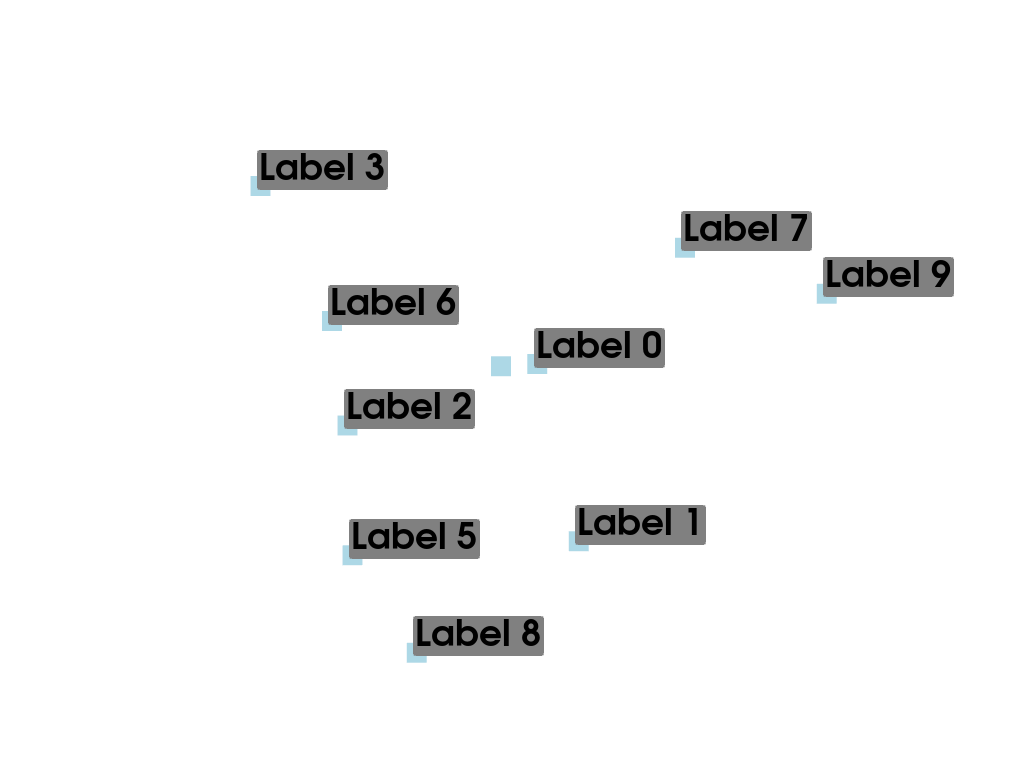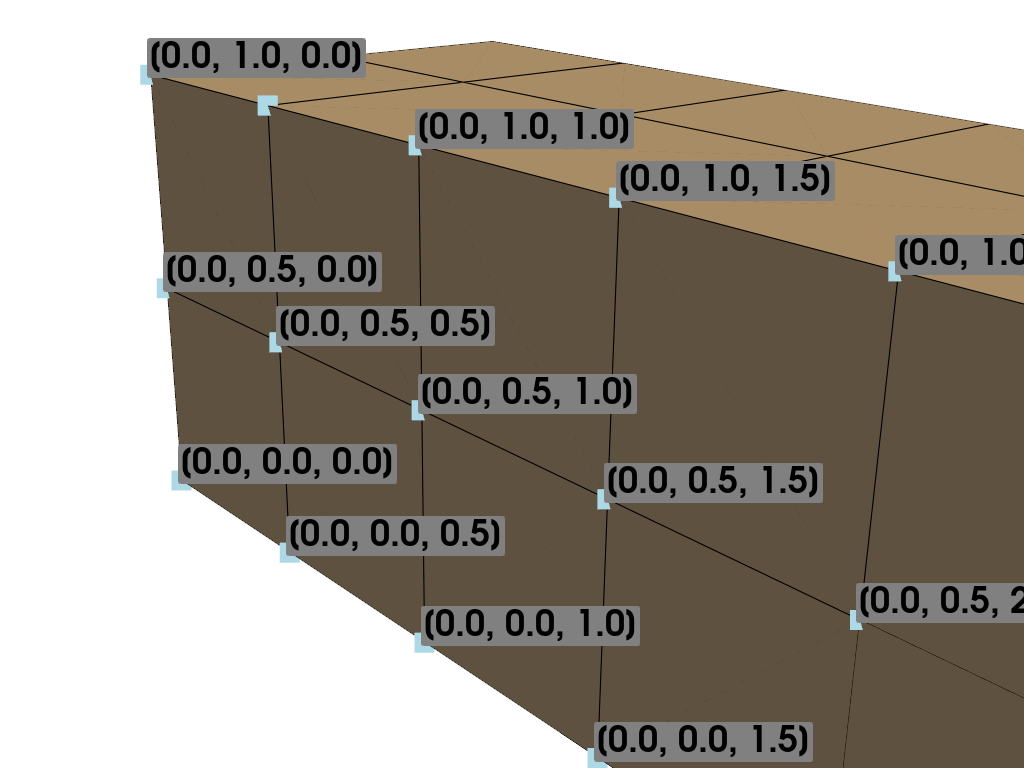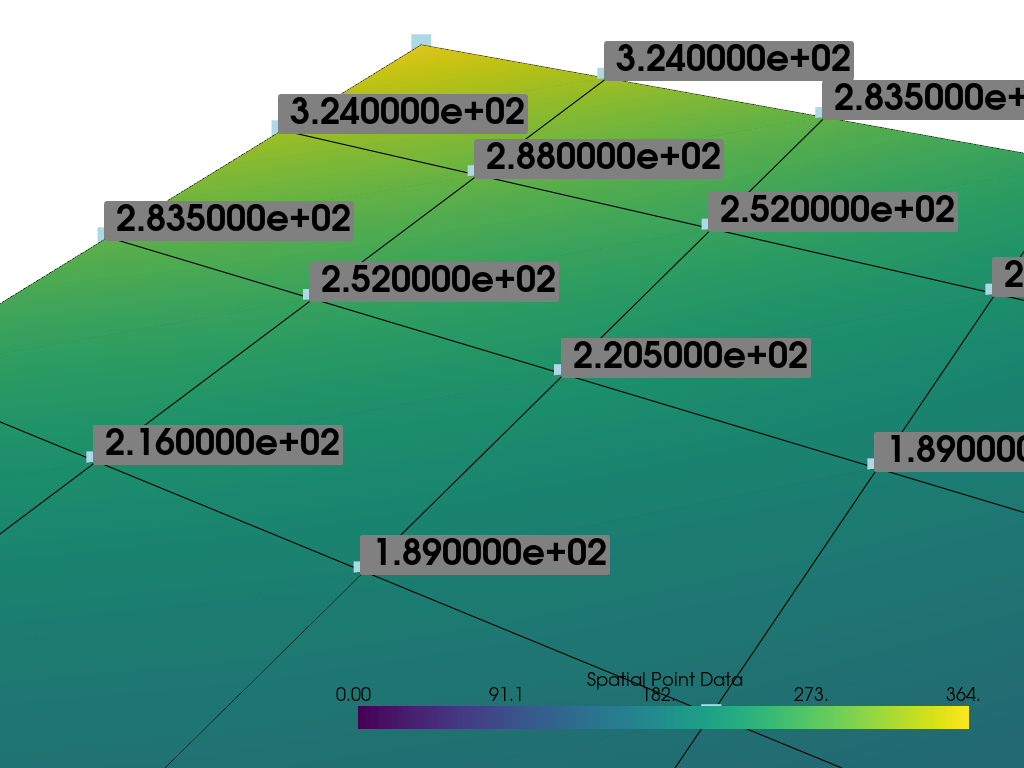注釈
完全なサンプルコードをダウンロードしたり、Binderを使ってブラウザでこのサンプルを実行するには、 最後に進んでください 。
ラベルポイント#
ポイントセットで文字列配列を使用してポイントにラベルを付ける
import numpy as np
import pyvista as pv
from pyvista import examples
pyvista.Plotter.add_point_labels() メソッドを使用すると,シーンにポイントラベルを簡単に追加することができます.
Help on function add_point_labels in module pyvista.plotting.plotter:
add_point_labels(self, points: 'MatrixLike[float] | VectorLike[float] | DataSet | _vtk.vtkAlgorithm', labels: 'list[str | int] | str', italic: 'bool' = False, bold: 'bool' = True, font_size: 'int | None' = None, text_color: 'ColorLike | None' = None, font_family: 'FontFamilyOptions | None' = None, font_file: 'str | None' = None, shadow: 'bool' = False, show_points: 'bool' = True, point_color: 'ColorLike | None' = None, point_size: 'float | None' = None, name: 'str | None' = None, shape_color: 'ColorLike' = 'grey', shape: "Literal['rect', 'rounded_rect'] | None" = 'rounded_rect', fill_shape: 'bool' = True, margin: 'int' = 3, shape_opacity: 'float' = 1.0, pickable: 'bool' = False, render_points_as_spheres: 'bool' = False, tolerance: 'float' = 0.001, reset_camera: 'bool | None' = None, always_visible: 'bool' = False, render: 'bool' = True, justification_horizontal: 'HorizontalOptions | None' = None, justification_vertical: 'VerticalOptions | None' = None, background_color: 'ColorLike | None' = None, background_opacity: 'float | None' = None) -> '_vtk.vtkActor2D'
Create a point actor with one label from list labels assigned to each point.
Parameters
----------
points : sequence | DataSet | :vtk:`vtkAlgorithm`
An ``n x 3`` sequence points or :class:`pyvista.DataSet` with
points or mesh-producing algorithm.
labels : list | str
List of labels. Must be the same length as points. If a
string name is given with a :class:`pyvista.DataSet` input for
points, then these are fetched.
italic : bool, default: False
Italicises title and bar labels.
bold : bool, default: True
Bolds title and bar labels.
font_size : float, optional
Sets the size of the title font.
text_color : ColorLike, optional
Color of text. Either a string, RGB sequence, or hex color string.
* ``text_color='white'``
* ``text_color='w'``
* ``text_color=[1.0, 1.0, 1.0]``
* ``text_color='#FFFFFF'``
font_family : str, optional
Font family. Must be either ``'courier'``, ``'times'``,
or ``'arial``. This is ignored if the `font_file` is set.
font_file : str, default: None
The absolute file path to a local file containing a freetype
readable font.
shadow : bool, default: False
Adds a black shadow to the text.
show_points : bool, default: True
Controls if points are visible.
point_color : ColorLike, optional
Either a string, rgb list, or hex color string. One of
the following.
* ``point_color='white'``
* ``point_color='w'``
* ``point_color=[1.0, 1.0, 1.0]``
* ``point_color='#FFFFFF'``
point_size : float, optional
Size of points if visible.
name : str, optional
The name for the added actor so that it can be easily
updated. If an actor of this name already exists in the
rendering window, it will be replaced by the new actor.
shape_color : ColorLike, default: "grey"
Color of shape (if visible). Either a string, rgb
sequence, or hex color string.
shape : str, default: "rounded_rect"
The string name of the shape to use. Options are ``'rect'`` or
``'rounded_rect'``. If you want no shape, pass ``None``.
fill_shape : bool, default: True
Fill the shape with the ``shape_color``. Outlines if ``False``.
margin : int, default: 3
The size of the margin on the label background shape.
shape_opacity : float, default: 1.0
The opacity of the shape in the range of ``[0, 1]``.
pickable : bool, default: False
Set whether this actor is pickable.
render_points_as_spheres : bool, default: False
Render points as spheres rather than dots.
tolerance : float, default: 0.001
A tolerance to use to determine whether a point label is
visible. A tolerance is usually required because the
conversion from world space to display space during
rendering introduces numerical round-off.
reset_camera : bool, optional
Reset the camera after adding the points to the scene.
always_visible : bool, default: False
Skip adding the visibility filter.
render : bool, default: True
Force a render when ``True``.
justification_horizontal : str, optional
Text's horizontal justification.
Should be either "left", "center" or "right".
.. warning::
If the justification is not default,
the shape will be out of alignment with the label.
If you use other than default,
Please use the background color.
See: https://github.com/pyvista/pyvista/pull/5407
justification_vertical : str, optional
Text's vertical justification.
Should be either "bottom", "center" or "top".
.. warning::
If the justification is not default,
the shape will be out of alignment with the label.
If you use other than default,
Please use the background color.
See: https://github.com/pyvista/pyvista/pull/5407
background_color : Color, optional
Background color of text's property.
background_opacity : float, optional
Background opacity of text's property.
Returns
-------
:vtk:`vtkActor2D`
VTK label actor. Can be used to change properties of the labels.
See Also
--------
:ref:`point_labels_example`
Examples
--------
>>> import numpy as np
>>> import pyvista as pv
>>> pl = pv.Plotter()
>>> points = np.array([[0.0, 0.0, 0.0], [1.0, 1.0, 0.0], [2.0, 0.0, 0.0]])
>>> labels = ['Point A', 'Point B', 'Point C']
>>> actor = pl.add_point_labels(
... points,
... labels,
... italic=True,
... font_size=20,
... point_color='red',
... point_size=20,
... render_points_as_spheres=True,
... always_visible=True,
... shadow=True,
... )
>>> pl.camera_position = 'xy'
>>> pl.show()
ラベル点群#
ランダムな点群を作り,各点に3次元空間上のラベルを付けてみよう.
# Make some random points
poly = pv.PolyData(np.random.rand(10, 3))
文字列ラベルをポイントデータに追加します.これにより,各ノードにラベルが関連付けられます.
poly["My Labels"] = [f"Label {i}" for i in range(poly.n_points)]
poly
pyvista.Plotter.add_point_labels() を使って,ラベルを付けて点をプロットします.
# (your code here, answer below)
plotter = pv.Plotter()
plotter.add_point_labels(poly, "My Labels", point_size=20, font_size=36)
plotter.show()

ラベルノードの位置#
この例では,メッシュの節点に座標位置のラベルを付けます.
# Load example beam file
grid = pv.UnstructuredGrid(examples.hexbeamfile)
プロッティングクラスを作成し,非構造化グリッドを追加します
plotter = pv.Plotter()
plotter.add_mesh(grid, show_edges=True, color="tan")
# Add labels to points on the yz plane (where x == 0)
points = grid.points
mask = points[:, 0] == 0
plotter.add_point_labels(points[mask], points[mask].tolist(), point_size=20, font_size=36)
plotter.camera_position = [(-1.5, 1.5, 3.0), (0.05, 0.6, 1.2), (0.2, 0.9, -0.25)]
plotter.show()

ラベルスカラー値#
この例では,各ポイントにスカラー値のラベルを付けます.
mesh = examples.load_uniform().slice()
pl = pv.Plotter()
# Add the mesh:
pl.add_mesh(mesh, scalars="Spatial Point Data", show_edges=True)
# Add the points with scalar labels:
pl.add_point_scalar_labels(mesh, "Spatial Point Data", point_size=20, font_size=36)
# Use a nice camera position:
pl.camera_position = [(7, 4, 5), (4.4, 7.0, 7.2), (0.8, 0.5, 0.25)]
pl.show()

Total running time of the script: (0 minutes 0.797 seconds)
